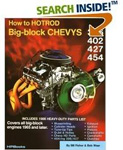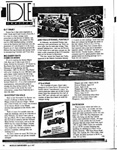![]()
Story below courtesy of Keith Seymore, Chevrolet Flint Assembly
Line Supervisor from 1979-1986 & GM Full Size Truck Engineering 1986-2009. Keith is a great guy with a ton of
cool and useful information about these trucks, and GM in general. Thanks for
this wonderful and entertaining article Keith!
I was reassigned to the GM Proving Ground in
Milford, Michigan in 1986. I was delighted to find my new office mate
John was, although a bit older than me, a former drag racer that still had
the bug. He was/is quite a charismatic man and drew the other racers
and motorheads to himself like flies to honey.
He also was the Engineering Vehicle Fleet Coordinator. That meant that
if you needed a certain type of truck for a particular test you went to see
John. That also meant that if you needed a Suburban for vacation over
the weekend, you also went to see John. He was a popular guy.
Well, just before I got there, he and his racing cronies had found a
nondescript little white short box stepside pickup in the fleet, vehicle
number CP5085. It started life as your typical 1985 small block pickup
truck, but the guys had been playing around a bit with it and decided it
could use a little more "punch". So - they found a garden variety 454
big block, plus all of the 1973 vintage parts (i.e., crossmembers, two piece
drive shaft, etc) to convert the driveline, and made themselves a little
454/TH400 powered street truck.
Naturally, after a little bit of that they decided they wanted more.
They were able to locate a real LS6 454 motor and dropped that in.
About that time they started taking short jaunts off property, including
"test sessions" to Milan dragway. Those who had been working on the
truck (on second shift, mostly) were given an opportunity to make a pass in
it. I think by this time the truck was running high 12s/maybe low
13's, and also starting breaking things. A 9.5" ring gear axle from a
3/4 ton truck, with the axle shafts re-drilled for a "5 on 5" bolt circle,
was installed about this time, as well as a rear mounted fuel tank (from a
Blazer/Suburban) and bed mounted battery.
Well, as you might guess, soon that wasn't enough. A trip to the parts
counter netted an original LS7 454 motor and within a day or so that was
installed. Times dropped to the low 12s and, with some tuning/cold
air, etc, dropped into the high 11's. By now a roll cage was necessary
and installed, as were some traction aids.
Unbeknownst to the rest of us John was taking us to the next level. He
had noticed something over in the parts warehouse: something not only
interesting for the present but with some historical value...
Back in late 1968 (calendar year), when the 1969 models were introduced,
there was a big event out on "Black Lake" (the Vehicle Dynamics pad).
The motoring press was invited in for this auspicious event and, on the pad,
were some special vehicles. Namely - two ZL1 all aluminum 427 powered
Corvettes, plus a smattering of ZL1 powered Camaros. In addition,
there was one engine placed on a stand, both for display purposes and as a
backup motor in case something happened to one of the engines in the car.
John had found this exact engine over in the warehouse.*
John approached the "owner" of the engine (i.e., the guy that had the
warehouse "property tag") and attempted to make a deal. He was
unsuccessful. He tried a couple times more later on and, even after
using all his charms, was still unsuccessful.
He was about to despair when suddenly the breakthrough came: this guy was
pulling his snowmobiles "up north" and needed a Suburban. With a gleam
in his eye John made the pitch and a deal was struck: just like Esau, who
sold his birthright
to Jacob for a
bowl of soup, this guy could have a Suburban in exchange for this original
ZL1 454 engine.
* This backup engine was not a 427 like the others, but was a 454.
It also appeared on magazine covers and in articles back in the day.
Here is a picture of that specific engine (i.e., not "one like it", or "of
this type", but THIS EXACT ENGINE):
It didn't take
long for that engine to be installed, running and tuned up (again, mostly on
second shift). Elapsed times dropped again, first to low elevens and
eventually to high 10's (best ET on the truck was a 10.71). Things
were going great; we were terrorizing the Proving Ground and we were having
a blast.
Then, things started to change. I came in to work one day and, laying
on my desk, was a clipping from an enthusiast magazine. The title was
"Is it True?" and the article said something about these engineers at the
Milford Proving Ground, and that they had put a 454 in a pickup and were
"...laying waste to unsuspecting Corvettes and Trans Ams..." or some such
thing. I thought it was pretty cool and mentioned it to John. He
didn't seem to think it was so cool for some reason.
Some time after that I came in and found
another piece of paper on my desk (this was back when we still had
"mail" - i.e., not email). We had a standard form letter, called a
"Vehicle Disposition Worksheet", that we got about once per week.
It told where vehicles were going, where they were shipped to, or what
they were doing. I scanned this particular letter until my finger
stopped cold on one line: "Vehicle CP5085 - Final Disposition - Scrap".
All the blood ran
from my face; John was sitting there and with a parched mouth I asked
"...John, why does this vehicle number look familiar?".
He looked around and said "...step into my 'office'". (Naturally,
we were already "in his office" - which was MY office, too. What
he meant was "come with me to my truck". As fleet coordinator, he
could order whatever vehicles he felt were necessary. One vehicle
that was ALWAYS necessary was a white/red Crew Cab dually, diesel, with
Alcoa aluminum wheels. He always had at least one of these vehicles in
the fleet, and since it was the "Queen of the Fleet", we always called
it "the Queen". A secondary meaning was that it was as large as
the Queen Mary. At any rate, "step into my office" = "come with me
to the Queen so that we can discuss this privately").
We sat in the truck in the parking lot and the story began to unfold:
Our boss, Jim, was a pretty easy going guy. He had kept a blind
eye to all this fun and frivolity, but every man has his breaking point.
When the little blurb in the magazine came out, well, that was the last
straw. He had called John into his office a couple Fridays before
and said (...and I quote...): "John, that truck has notoriety far beyond
what you think or imagine. I want it gone and I want it gone
NOW!".
John could see that Jim was in no mood for negotiation. However,
by the next Monday (after this meeting), when things had cooled down a
bit, he had a proposal. The truck was currently broken (broke a
rocker arm stud) and not running. Could he repair the engine, so
that the motor could be stored as an intact, functioning unit, and THEN
scrap the truck? Jim thought that would be ok, so the plan was
carried out. The truck was repaired, stripped of all the goodies,
and the remaining hulk (i.e., cab, box and frame) scrapped.
CP5085 was no more...
...Or was it?...
Some of you
may already be familiar with the GM "PEP" program (i.e., "Product
Evaluation Program"), whereby vehicles can be ordered and driven as a
company vehicle and then purchased at a discount. John was also a
PEP driver and when it came time for his next vehicle we were all amused
to see the cutest little red 1987 Chevy V6 short-box stepside pickup
arrive with his name on it.
John drove the truck for the required 3000 miles and purchased it.
Almost immediately after it got home the V6 was removed (and sold), a
454/TH400 driveline installed and much of the technology from CP5085
added. Out of the box John's little red truck was running low 11's
and shortly thereafter dipped into the high 10's. Many observers at the
track thought it was simply the original white truck with a new red
paint job.
You might be wondering if the engine in this new truck was aluminum or
cast iron. It's cast iron (...we checked.... with a magnet).
I've asked John where the aluminum engine is, my interest being in
preserving a piece of history, and he will only tell me "it's
safe". To this day I do not know where it is but only that "it is
safe".
I really have to stop and comment for a minute on how much I learned
during this time, even though by then I had been racing almost 10 years.
John really helped me learn the value of collecting data and analysis,
tricks and tuning of a big Chevy and if it weren't for him and the guys
my race program would not be where it is today.
CP5085 lives on, not only in my heart but in the abilities of those who
were involved with it and are continuing to take what we learned and
apply it to our own race programs.
Let's play a game. How many mistakes can you find in this little article?
Let's begin -
1) "Rumor has it" - well, as you can see, it was no rumor. It was for
real!
2) "...some engineers at GMC Truck and Coach..." - no, by then we were GM
Truck and Bus. Truck and Coach implies the bus factory in Pontiac; we
were obviously located in Milford.
3) "...found a fresh ZL1 in a crate in a dusty storage room somewhere in the
bowels of Detroit..." - not correct, unless you consider Milford to be "the
bowels of Detroit". And - the warehouse is not dusty. It's pretty
clean.
4) "...they jerked the 454 out of a 1986 short-bed pickup..." - we've already
established it was originally a small block truck and was a 1985 short-box,
not an '86.
5) "...switched over all the brackets and hardware onto the aluminum 427..."
- as discussed, this specific motor was a 454 rather than a 427.
6) "..it's been screaming around the Milford Proving Grounds and laying
waste to unsuspecting Corvettes and Trans Ams." - well, ok, that was true...
Just a friendly reminder to not believe everything you read... (except from
me, of course!).

